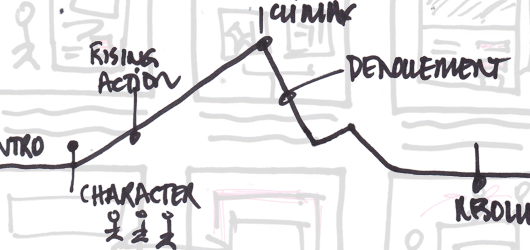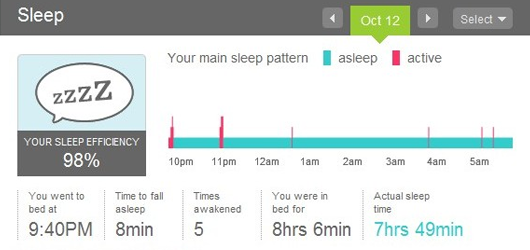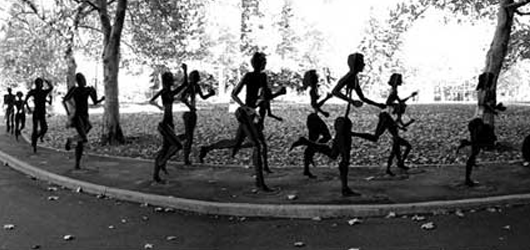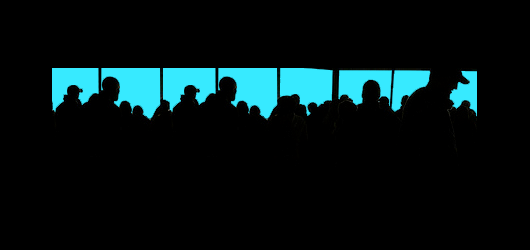Today I’m writing over on UX Magazine about some ideas I have on the parallels between making a movie and making a great experience. At the heart of a great film is a set of very well developed characters and the story of some specific experience in their journey. Continue reading
Why We Need Product Storytellers At The Heart Of Product & Technology
Update: This post received a lot of great feedback and was re-written in more detail as an article for UX Magazine.
I am not a designer.
The word ‘design’ is far too limiting. What I really do is tell stories. I ask questions, find answers, and figure out how to distill a vision and idea into a product story.
There’s a lot of talk right now in the start up world about creating a founding team and whether a founder should hire technical or product first. The answer is more than obvious.
Technology is a means by which the product is brought to life.
But, without a story for the product, the rest of the team doesn’t don’t know what to build, sell, and evangelize. I’ve seen this happen over and over.
A founder has an idea and hires a team, but often doesn’t have strong product perspective on that team. Then, someone like me comes in, talks to the founder, and synthesizes the vision into a story and prototype, leading to the realization that what the founder envisioned is not what’s being created.
A founder has the vision. A founder provides the starting point. A founder has the initial idea … but a product is more than an idea. A product is more than a website. A product is more than a transaction. A product creates a relationship that produces an experience that brings added value to someone’s life.
In the article The Science of Relationships, I asked the question:
“How can we transform advertising from a series of static touchpoints with a brand to a dynamic network of thoughtfully designed interactions that are tailored to and seamlessly blend with people’s lifestyles – creating a strong brand connection – a lifelong marriage with the brand.”
We need to start thinking about products as relationships. Every company needs a product story that clearly outlines how a relationship will be created and sustained with every person that engages in the product. Part matchmaker, part marketer, part technologist, part artist, part strategist … the product storyteller liaises between all areas of an organization to ensure to that everything being created is helping to strengthen the relationship that the product has with the consumer.
Today we are feeling the effects of not having enough product storytellers. This hinges on the fact that too many people who call themselves designers lack the fundamental skill of storytelling. Before you can communicate anything visually, you have to establish the story that your visualization or experience is going to tell.
To every designer, you need to become a better product storyteller. You need to stop focusing on the pixels and think about the plot, the people, and the product. Write more. Ask questions. Become an expert in relationships.
To every technologist, I respect you. I also know enough of you to know that you feel the frustration and often have to do things over and over due to an unfocused product vision. So please understand that in saying that product should come first, I do this so that when you embark on creating a product, the vision is established and you can focus on creating great technology, not deciphering a disconnected vision.
To every founder, never stop having ideas. It’s because of people like you that new amazing products are brought to market. But, in a society where attention spans keep getting shorter and shorter, please realize that it is the product that establishes the strongest relationships that will win. So before you do anything else, establish your product’s story.
Update # 1:
This post received a lot of great feedback and was re-written in more detail as an article for UX Magazine.
Update # 2:
I’ve been asked to speak on the idea of product storytelling a few times. Here are the slides from one of my talks:
The New ROI: Reach Of Influence
When it comes to measuring the success of marketing communications, brands need to change they way they think. It’s no longer about Return On Investment, it’s about Reach Of Influence.
In a recent Nielson Company report, the monthly minutes the average US consumer dedicated to some type of social network activity increased by 210 percent from December 2008 to December 2009. This rapidly growing social environment is one that brands need to learn how to engage in and, more importantly, measure. It’s no longer just the voice of the brand, its the voice of community, and that voice is louder and more influential than ever before.
Social technology allows for anyone with Internet access be either a brand ambassador or an adversary. As technology continues to seamlessly blend with our lives, communities, and conversations, measuring the influence of consumer-to-consumer relationships will become a central building block to the new metrics that are needed.
Industry experts agree that current metrics are insufficient and outdated. In the AdAge article Taking Online-Ad Measurement Beyond the Click, Abbey Klaseen wrote about the scrutiny of whether it’s effective to use a click to measure online advertising. The argument is that the click does not take into account into any other influencing factors, whether prior online expose or offline marketing activity. Andrea Kerr Redniss, Senior VP-digital at Optimedia comments concerning the click measurement, “It’s the closest thing to a standard, but it doesn’t mean anything to anybody, and CMOs are just tired of hearing about it.”
A measurement such as Reach Of Influence is about understanding how individuals are able to extend the reach of a brand’s marketing communications from simply business-to-consumer to consumer-to-consumer. In effect, this would allow brands to measure how the life of a particular piece of media is extended as it is shared from person to person within an individual’s network.
New social technologies have made the creation of content more accessible to the general Internet user resulting in a drastic increase in user generated content. Further, it is expected that soon the information on the Internet will double every 72 hours – partially due to the democratization of content creation. If brands are finding it difficult to reach users today and measure the effectiveness of their messages, it would appear as their challenges are only just beginning.
Instead of focusing on being heard in a sea of user generated content (of which, security firm Websense reports that 95% of all user generated content is spam), brands should change their focus to develop a more thorough understanding of user referred content. Being able to quantify the total reach of a piece of media by way of a single individual’s influence within their social communities will be integral to the future of successful campaigns.
Traditional marketing communications measurements are no longer relevant. A click measurement doesn’t provide a full understanding of the influencing power of the community. Industry experts agree that it is time for a new standard. As the social environment continues to rapidly evolve, brands need to have new metrics that measure the impact of the conversations within this environment. A measurement such as Reach Of Influence would provide greater insight into the influence of the individuals, and not just the piece of content.
How Personal Metrics Can Change Our Lives
America is trapped in a consumption driven lifestyle, and the consequences of our actions are being revealed more now than ever before. Our economy has reached a state of turmoil not seen since the Great Depression. In March 2009, the collective credit card debt of Americans was just over $940 billion. Our nation’s obesity levels have reached ultimate highs with two thirds of adults and one third of children in America are obese. And, we are in the middle of a massive climate crisis. The United States per capital carbon dioxide emissions in 2005 were more than four times greater than China’s and almost fourteen times India’s.
Have we become blind to the consequences of our actions?
There is an eminent need to quantify our behavior and bring more transparency and understanding to the effects that our actions have.Continue reading
The Culture Of Identity
Throughout history, we have witnessed great change – the fall of capitalism, the Industrial Revolution, and now the technology revolution. Central to all these periods of change we find commonalities that remain true. In all periods of change – the individual never changes. Though the individual may change the way he does things or goes about his daily life, he as a person never changes, his emotions, spirit, and need for discovery of self and identification with others remains strong.
In his book The Rise of the Network Society, Manuel Castells focuses on the interface between technology and society, which he refers to as the relationship between the net and self. This relationship stems from the increased desire for identity and self discovery which is often the only source of meaning in a society that is going through rapid and radical change – such as the change brought forth in the technological revolution.
Marshall McLuhan presented similar ideas Continue reading
The Science Of Relationships
“Today we are faced with the preeminent fact that, if civilization is to survive, we must cultivate the science of human relationships – the ability of all peoples, of all kinds, to live together and work together, in the same world, at peace.”
Franklin Roosevelt wrote these words as part of his 1945 Jefferson Day speech. Although he died before he could deliver his message, his words still challenge us today – do we really understand the science of relationships?
In the book Vital Friends, Tom Rath writes about the absolute necessity for friends both in our personal and professional lives. One of his key arguments is that due to the nature of our society, we are far too focused on ourselves. As a result, we diminish the impact of relationships in our lives because we are too busy looking at what someone is not providing us with – expecting them to be everything – rather than in order to have healthy, productive, and mutually beneficial relationships, we need to focus on what each friend does to contribute to our lives.
In the same way that we need to focus on building relationships for ourselves, we also need to realize the critical need for cultivating the science of human relationships in marketing and design.
In a previous post, I wrote about the Purpose of Community – where in the midst of constant change, people are searching for new opportunities to unite with others based on their newly found identities.
I think the key to creating effective community will be directly related to our ability to execute the science of human relationships.
How can we transform advertising from a series of static touchpoints with a brand to a dynamic network of thoughtfully designed interactions that are tailored to and seamlessly blend with people’s lifestyles – creating a strong brand connection – a lifelong marriage with the brand.
Design + Change
We are in an era of immense global change where technology is creating a society that, although it is more connected, its people are arguably discontented because of an overall lack of cultural cohesion and a general sense of dehumanization.
Society is driven by the individual and each person’s unique journey to define themselves and find contentment of self apart from the collective ideas of the global village. This drive for individualism is necessary. However, we must find a way to resurrect the power, passion, and possibility that exists within a community.
In the midst of this postmodern time, a global perspective is emerging that focuses on community rather than the individual – realizing that we do not exclusively think or exist independently of the community with which we immediately identify. In order to design products, services, experiences, and Continue reading
The Purpose Of Community
Technology has undoubtedly had a dramatic change on our society. It has given us a new medium of communication that is creating a globally connected world where traditional boundaries mean less and less.
I am continually challenged by Manuel Castells’ book – The Rise of the Network Society. Castells addresses this concept and suggests that there is an increasing fragmentation between the group and individual due to the individual’s quest for self discovery in the midst of feeling lost in a world of incessant change.
We must realize that as a result of the individual’s increased search for identity, new social groups are being formed – made up of unique groups of individuals, all of whom are searching for connectedness based on their newly found identities.
I believe that a community has three goals: hear, understand, respond.
With the rise of social networking websites that are designed to bring people together, there seems to be a lack of meaningful substance lacking. Although these sites are effective at creating new social groups – I strongly believe that they lack a key elements of community – the ability to respond.
I think that the effectiveness of future of communities is directly related to our ability to engage with individuals on a personal level and provide them with meaningful, challenging, and customized content that will engage them and give them a forum to respond – to take action – to change their lives.
It is my passion to create meaningful messages and tools that provide people with the tools the need to hear, understand, and respond.







